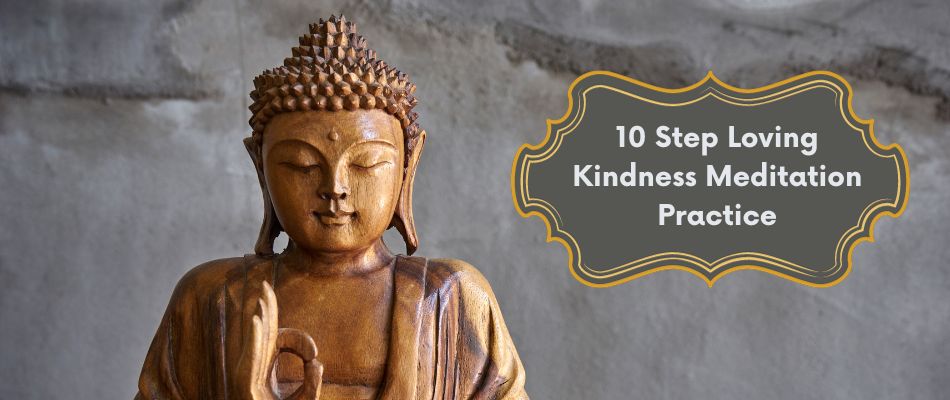A student came to me struggling with really difficult events in her life including some health surprises, care for aging family members, and things not going well at home and at work. She was intelligent enough to realize that the worry, self-loathing, criticism of others, and poor interactions were making everything more difficult. Loving Kindness Meditation (LKM) seemed like the perfect solution with its promises to increase compassion for herself and others, let alone the good vibes promised by its practitioners. That was until she abandoned it.
Loving Kindness Meditation is a mindfulness practice for nurturing positive emotions and attitudes towards oneself and others. It is rooted in a traditional Buddhist idea known as “Metta” developed to foster a more permanent sense of happiness, empathy, and connectedness.
There is an assumption in most of the literature and testimonials on LKM that by simply following a loving kindness meditation script you feel better immediately. This isn’t true for everyone which is sad because they may stop something they could really benefit from. If you don’t feel better, should you quit or how long should you work at it? Are you meditating incorrectly or is it just not a good fit for you?
More problematically, what if it makes you feel worse? For some, practicing self-compassion meditation is initially more painful because thinking about what you are up against in life can actually make you feel worse. This was certainly true for the woman in my class. It wasn’t until she understood more about loving-kindness meditation and saw how long people invested in the process, that she was successful at giving it another shot.
If you have ever felt a negative reaction to something that is supposed to make you feel better, it can be extremely unsettling. Seeing others experience wild success while you don’t, can make you feel like you are in need of some real serious help. Especially when loving kindness meditation YouTube videos show practitioners smiling away after 5-20 minutes.

I don’t think a lot of people are talking about how difficult self-compassion is at the beginning and no one is admitting to how many people abandon it. But this doesn’t have to be the case. Fitzgerald’s quote about the “dark night of the soul” is a perfect metaphor:
“In the real dark night of the soul it is always three o’clock in the morning, day after day.”
F. Scott Fitzgerald
In order to pass through difficult times and benefit from something like Loving Kindness Meditation, we need some motivation and knowledge to stay the course. This way, we can trust the process and spend enough time evolving for the meditation to work its magic.
I want to be clear that I am an advocate for compassion meditations but I fear that the path from pain to promise is a bit blurry when the distance between the two is quite large. Yes, one can contemplate themselves into a better and more accepting state. And yes, this change can be made permanent over time as a person lays the groundwork to actually become someone who is less reactive, more tolerant, and more accepting of their present state.
However, this becomes easier when we see how Loving Kindness Meditation historically fits into Buddhism and understand the thousands of years of development that went into its evolution. Secondly, with most of us not growing up in a Buddhist culture, we benefit by seeing how modern scientific studies are proving what Buddhists have been saying all along. These two contexts will enable you to stay the course.
Let’s jump into Buddhism and a bit of science so that it is clear what we are working towards. Then, we will highlight easy-to-follow scripts and loving kindness guided meditation that take the original instructions and scientific findings into account.
What’s In This Essay
- The Relationship Between Loving Kindness Meditation and Buddhism
- Modern Science Weighs in Demonstrating the Benefits of Loving-Kindness Meditation
- 10 Steps to Loving Kindness Meditation – On Your Own
- Using a Guided Loving Kindness Meditation – Follow Along
The Relationship Between Loving Kindness Meditation and Buddhism
While loving-kindness meditation has gotten all of the press and popularity, it is actually one of four mental states that practitioners of Buddhism aim to cultivate. The teachings of Buddhism have evolved over the centuries developing practices to liberate a person from suffering and grow spiritually. Loving-kindness or “Metta” is one of the four Brahma Viharas, or sublime attitudes that help a practitioner get there. The other three are compassion (Karuna), sympathetic joy (Mudita), and equanimity (Upekkha).
Obviously thousands of years of development cannot be summed up in a few paragraphs but there are some key points that help us understand the importance of loving-kindness meditation that is far deeper than its fluffy, feel good reputation (It does feel good by the way though!).
Loving-kindness goes all the way back to the initial inception of Buddhism.
Loving-kindness meditation is believed to have been taught by the first Buddha, Siddhartha Gautama, as a method to cultivate love, compassion, and goodwill toward all beings. It is an integral part of the Buddhist tradition and is found in various Buddhist texts, including the Pali Canon and the Visuddhimagga. Despite its recent popularity, you can be assured that you are investing your time into a tradition that has been honed across the centuries.
You are participating in something greater than yourself.
Loving-kindness meditation is closely tied to the ethical principles of Buddhism, including non-harming (ahimsa) and the cultivation of compassion for all beings. Practitioners of loving-kindness meditation are encouraged to extend feelings of love and goodwill not only to loved ones but also to neutral individuals, difficult people, and even enemies.
I love the ethical component of this meditation because it adds an edge or a fierceness to the practice. Basically, it is your right to feel contentment and this right extends to all living things.
Suffering is part of being human and no one is excluded.
Buddhism teaches that suffering (dukkha) is an inherent part of human existence and is caused by attachment, aversion, and ignorance. I feel a real sense of relief when I think of suffering in this way because I am reminded that I am not alone in how I feel and that there is a solution!
Loving-kindness meditation is seen as a way to reduce suffering by cultivating positive emotions and breaking down barriers of aversion and ill-will. By developing love and compassion, practitioners can reduce the causes of suffering in themselves and others.
Loving kindness meditation develops interconnectedness.
Loving-kindness meditation encourages practitioners to see all beings as deserving of love and happiness, regardless of their background or actions. This aligns with the Buddhist view of the interconnectedness of all life. Depression, suffering, or any negative emotion are often caused or made worse by feelings of loneliness. This is a powerful aspect of this practice because by seeing the relationship between yourself and all others, it makes what you are going through feel like a shared experience. This is definitely true of tai chi, and if you are looking for an example we wrote an article on tai chi’s relationship to depression.
Loving-kindness meditation is at the core of Buddhist practices, emphasizing the cultivation of positive qualities, compassion, and the reduction of suffering. For those of us not steeped in Buddhism, it gives us access to the benefits of the art in a really digestible way.

Modern Science Weighs in Demonstrating the Benefits of Loving-Kindness Meditation
Let’s swing completely the other direction now and leave history to arrive at a modern-day examination of loving-kindness meditation. Westerners wouldn’t be Westerners without leaning heavily on the analytics of science to either back-up or refute the claims of ancient practices. Sometimes it goes overboard and sometimes it’s needed.
With the overwhelming changes brought on by the recent health pandemic, many people have faced strife in their life while at the same time our medical and mental health systems have been overrun. Add to this that many people experienced job loss (which equates to a loss of healthcare in the U.S.) and you have a perfect storm of human suffering with little to no support. It makes sense that governments would fund studies to find a way to 1) help people by 2) reducing their suffering with something that 3) can be done in isolation and 4) be cost effective. Enter stage left, numerous research studies on the benefits of loving kindness meditation.
More than anything, what I want you take away from this section is that many of the benefits of loving kindness meditation have been scientifically verified and that the studies were not short! Clicking through to the actual methods you will see that they obtained their results from measuring the outcomes of practitioners who took part in 4, 6, and 8+ week studies.
The Benefits of Loving Kindness Meditation Include:
1. Reduced Symptoms of Anxiety and Depression
Loving-kindness meditation has been shown to reduce symptoms of anxiety and depression, promoting emotional well-being. A study published in the “Journal of Consulting and Clinical Psychology” (Jain et al., 2007) examined the effects of Metta meditation on participants with generalized anxiety disorder. The results indicated significant reductions in anxiety symptoms.
Reference: Sears, S., & Kraus, S. 2009 – Journal of Consulting and Clinical Psychology
2. Increased Positive Emotions
Regular practice of Metta meditation can lead to increased positive emotions such as joy, love, and compassion. Fredrickson et al. (2008) conducted a study and found that loving-kindness meditation led to substantial increases in positive emotions and life satisfaction.
Reference: Fredrickson et al., 2008 – Psychological Science
3. Improved Well-Being and Life Satisfaction
Loving-kindness meditation has been associated with greater overall well-being and life satisfaction. A randomized controlled trial published in “Mindfulness” by Bolier et al. (2013) showed that Metta meditation, when integrated into mindfulness-based therapy, significantly improved overall well-being. An amazing aspect of this study is they used mobile phones with adolescents and still got results!
Reference: Donovan, E. et al. 2016 – Journal of adolescence
4. Enhanced Social Connection and Empathy:
Metta meditation has been found to enhance social connection and empathy towards others. An investigation published in the “Psychological Science” journal by Hutcherson et al. (2008) demonstrated that Metta meditation increased feelings of social connection and prosocial behavior.
5. Stress Reduction
Loving-kindness meditation has been shown to reduce stress levels and improve the body’s stress response. A study conducted by Hoge et al. (2013) and published in “Psychoneuroendocrinology” found that Metta meditation led to reduced stress-induced inflammation and improved stress resilience.
Reference: Hoge et al., 2013 – Psychoneuroendocrinology
6. Enhanced Focus and Attention
Regular practice of loving-kindness meditation can improve attention and cognitive performance. A study published in “Psychological Science” by Jazaieri et al. (2012) demonstrated that Metta meditation enhanced attention and cognitive control.
Reference: Jazaieri, H. et al. 2014 -Motivation and Emotion

10 Steps to Loving Kindness Meditation On Your Own
At the outset, loving-kindness meditation looks like any other style of meditation but then it takes on very specific characteristics. Imagine relaxing, then mentally drawing a circle around yourself, then allowing the circle to expand to include people you care about, people you have difficulty with, and eventually everyone on the planet.
It’s often difficult to think good thoughts about people who frustrate you who are treating you badly but real freedom from their torment is possible if you can get to a place of equanimity. Crossing this distance is made easier because the emotion is drawn up on yourself and other loved ones first, and then transferred over to the not-so-kind person. It’s a lot easy to expand an emotion rather than trying to manufacture it on the fly.
There are specific loving kindness meditation scripts that you can use which we will get into next but know that you can adapt the following routine to match the people in your life and the circumstances that you want to change.
There are two essential components to this style of meditation needed in order to make it successful: More is better, practice at least daily so the emotion you experience isn’t a distant memory. Otherwise, it will be more difficult to bring those positive feelings back into your reality.
Secondly, don’t exclude or downplay yourself. Another thing that makes LKM unique is that you are required to treat yourself as well as you would treat others. This alone is hard for many of us to accept. Also, juxtapose this against traditional Western prayer which rarely focuses on the person saying the prayer. Save a little compassion for yourself.
Here are the nuts and bolts of a successful practice but alter the statements to fit your needs:
1. Find a Comfortable Meditation Posture
Sit in a comfortable and upright posture, either on a cushion or a chair. You can also practice Metta meditation while lying down if that’s more comfortable for you.
2. Set an Intention
Begin by setting a clear intention for your meditation. This could be something like, “I will cultivate feelings of love and compassion for myself and others.”
3. Focus on Your Breath
Take a few deep breaths to center yourself. Then, breathe naturally and bring your attention to your breath. Notice the sensation of your breath as it goes in and out.
4. Begin with Yourself
Start by directing loving-kindness towards yourself. You can use phrases or affirmations to do this. For example:
“May I be happy.”
“May I be healthy.”
“May I live with ease.”
5. Extend Loving-Kindness to Others
After generating feelings of loving-kindness for yourself, shift your focus to others. Start with someone you care about deeply, such as a close friend or family member. Repeat the phrases for them:
“May [Name of Specific Person] be happy.”
“May [Name of Specific Person] be healthy.”
“May [Name of Specific Person] live with ease.”
6. Expand to Neutral Individuals
Extend your loving-kindness to individuals you have neutral feelings about – people you neither like nor dislike. Repeat the phrases for them as well:
“May all people/individuals be happy.”
“May all people/individuals be healthy.”
“May all people/individuals live with ease.”
7. Extend to Challenging Individuals
Now, challenge yourself by extending loving-kindness to individuals you may have conflicts with or negative feelings towards. This can be a powerful practice for transforming difficult relationships:
“May [Name of Specific Person] find happiness.”
“May [Name of Specific Person] be free from suffering.”
“May [Name of Specific Person] live with ease.”
8. Widen Your Circle of Compassion
Gradually, expand your circle of compassion to include all beings, without exception. You can use phrases like:
“May everyone in the world be happy.”
“May everyone in the world be healthy.”
“May everyone in the world live with ease.”
9. Maintain a Gentle Focus
Throughout the meditation, maintain a gentle and loving focus on each person or group you’re sending Metta to. Feel the warmth and compassion in your heart as you repeat the phrases.
10. Close the Meditation
When you’re ready to end your meditation, take a few deep breaths, re-center yourself, and slowly open your eyes. Take a moment to reflect on the practice and any feelings or insights that arose.
Using a Guided Loving Kindness Meditation – Follow Along
With such an abundance of great resources online there really is no reason to go it alone these days. Now that you have an understanding of the value, history, and researched benefits of loving kindness meditation, you are more likely to stick with the practice and experience the benefits for yourself.
Definitely practice on your own. But, videos with music and nice scenes make the practice so much more enjoyable and interesting. They can help you get over the hump of not practicing often enough or not long enough to permanently change your outlook. It’s easy to find a guided loving kindness meditation that matches your personality and what you want to focus on. Several authors such as Sharon Salzberg and Tara Brach have created really nice guided loving kindness meditations to follow along to. I tend to lean towards established practitioners a lot more here than with the many other styles of meditation. These experts have dealt with the different nuances of the practice and are able to make practitioners experience real results. Here are a few examples to get you started:
Sharon Salzberg Loving Kindness Meditation – 10 minutes
Sharon Salzberg Loving Kindness Meditation – 20 minutes
Loving Kindness Meditation with Tara Brach
5-Minute Loving-Kindness Meditation with Script
Lastly, looking for a challenge? Sharon Salzberg has put together a 10-Day Loving Kindness Meditation YouTube Challenge! 10-Day LKM Challenge



